A colaboração é um processo delicado e sensível cujos resultados são determinados por um número indefinido de fatores.
Ela não precisa apenas ser devidamente organizada, mas também cuidadosamente curada, modificada e mantida ao longo dos vários estágios e aspectos de seu curso.
Se você passar tempo suficiente envolvido em trabalho colaborativo, seus inúmeros benefícios certamente se revelarão. No entanto, você quase certamente também experimentará o estresse, a frustração e a ineficiência que inevitavelmente surgem de tempos em tempos ao trabalhar com outras pessoas.
A colaboração em si não remove inerentemente nenhuma dessas desvantagens. Em vez disso, cabe às equipes e organizações criar um ambiente que facilite a eliminação, a minimização e/ou o gerenciamento delas.
Neste artigo, focamos nas aplicações práticas do trabalho colaborativo e nas principais práticas e princípios que podem ajudar a elevá-lo a um nível mais alto.

Por que a colaboração produtiva em equipe é crucial para todas as empresas?
Há muito tempo, Hellen Keller disse: "Sozinhos, podemos fazer tão pouco; juntos, podemos fazer tanto."
Steve Jobs implementou essa noção em um ambiente empresarial e disse: "Grandes coisas nos negócios nunca são feitas por uma pessoa; elas são feitas por uma equipe de pessoas."
A importância da colaboração em equipe tem sido, sem dúvida, reconhecida desde então ― especialmente no mundo agitado de hoje, onde as empresas enfrentam problemas reais em termos de melhoria da colaboração e produtividade da equipe.
A epidemia de esgotamento, os desafios dos modelos de trabalho remoto e híbrido, e a luta para sdefinir limites entre vida pessoal e profissional levaram à importância crescente da colaboração eficaz em equipe. Mas, alcançar uma boa colaboração em equipe é certamente mais fácil dizer do que fazer.
Por outro lado, a sobrecarga colaborativa não é um mito.
De acordo com um artigo da Harvard Business Review, a sobrecarga colaborativa é definida como a influência negativa de muito trabalho em equipe, o que leva a menos produtividade e funcionários se sentindo exaustos.
Os dados mostram que em muitas empresas mais de 80% do tempo de trabalho é gasto em atividades colaborativas, como:
- Responder e-mails
- Fazer chamadas de voz
- Participar de reuniões
Esse número aumentou progressivamente durante a pandemia ― como mencionamos, modelos de trabalho remoto e híbrido criaram novos desafios em termos de colaboração, já que as reuniões virtuais se tornaram o novo normal nas bases diárias.
No entanto, pesquisas mostram que 39% dos funcionários acreditam que as pessoas em sua organização não colaboram o suficiente.
Considerando tudo, podemos concluir que a colaboração produtiva da equipe requer a manutenção de um bom equilíbrio. Embora a colaboração da equipe deva ser priorizada, é necessário evitar a sobrecarga colaborativa encontrando um equilíbrio com atividades colaborativas.
Quais são os principais benefícios de uma equipe colaborativa?
Antes de mergulharmos nas melhores práticas para colaboração produtiva em equipe, vamos dar uma olhada nos maiores benefícios de uma equipe colaborativa.
Benefício #1: Uma equipe colaborativa contribui para a resolução de problemas
“Duas cabeças pensam melhor que um.”
― John Heywood
A sinergia da equipe capacita a colaboração da equipe com diferentes perspectivas que podem trazer alguns novos valores à mesa. Isso ajuda os membros da equipe a fazerem seu melhor.
Em outras palavras, duas ou mais pessoas têm mais probabilidade de encontrar soluções relevantes e tomar melhores decisões do que uma única pessoa.
Combinar o conhecimento dos membros da equipe e compartilhar ideias e pensamentos é um dos maiores poderes da colaboração da equipe.
Resolva problemas e faça um brainstorming sobre o Pumble
Benefício #2: A equipe colaborativa incentiva o compartilhamento de habilidades e conhecimentos entre os membros da equipe
Além de contribuir para a resolução de problemas, uma forte cultura colaborativa permite que os membros da equipe aprendam uns com os outros.
O compartilhamento de habilidades e conhecimento entre os membros da equipe com diferentes origens, níveis de experiência e pontos de vista leva ao aumento da produtividade.
Benefício #3: Uma equipe colaborativa aumenta a produtividade e o engajamento
De acordo com um artigo da Forbes article sobre a influência da colaboração na produtividade dos funcionários, um ambiente colaborativo "cria uma força de trabalho engajada, onde cada pessoa se sente como um membro contribuinte de uma equipe unificada".
Além disso, estudos mostram que essa experiência os capacita com mais motivação intrínseca, o que leva a mais engajamento e 50% mais eficácia na conclusão de tarefas.
Portanto, a dinâmica da colaboração eficaz não contribui apenas para a resolução de problemas e compartilhamento de conhecimento mas também melhora a saúde mental dos indivíduos envolvidos.
5 Princípios de uma boa colaboração
Em sua obra altamente influente How to Make Collaboration Work, o autor David Straus se propôs a fornecer indicadores para a criação de um ambiente colaborativo produtivo que contorne os efeitos colaterais negativos do processo e enfatize os valores da colaboração e os aspectos alegres de trabalhar em conjunto.
Um explorador e praticante de longa data da "resolução colaborativa de problemas", Straus confiou em décadas de sua experiência como líder, consultor e treinador para destilar 5 princípios-chave da colaboração eficaz.
Os 5 princípios de Straus são:
- Envolver as partes interessadas relevantes.
- Construir consenso fase por fase.
- Criar um mapa de processo.
- Designar um facilitador de processo.
- Aproveitar o poder da memória de grupo.
Nas próximas linhas, analisaremos cada um deles mais detalhadamente.
Princípio #1: Envolver as partes interessadas relevantes
“O poder da colaboração vem da inclusão, não da exclusão.”
– David Straus
A princípio, pode parecer óbvio que a colaboração deve incluir todos com interesse ativo em seu resultado e/ou na expertise relevante.
Na prática, esse geralmente não é o caso. Indivíduos e grupos que podem impactar significativamente o curso da colaboração são frequentemente excluídos do processo.
Isso pode acontecer involuntariamente, quando uma organização falha em identificar adequadamente os participantes relevantes, ou intencionalmente, se uma pessoa ou um grupo em questão for considerado confrontacional ou oposto à colaboração ou às atividades planejadas, apesar de possuir a expertise relevante ou uma palavra a dizer no processo de tomada de decisão.
Para identificar adequadamente todas as partes relevantes, Straus criou 4 categorias de pessoas relevantes:
- Com o poder formal de tomar uma decisão
- Com o poder de bloquear uma decisão
- Afetadas por uma decisão
- Com informações ou experiência relevantes
Mantenha todos informados com o Pumble
Categoria #1: Aqueles com poder formal para tomar uma decisão
O envolvimento de tomadores de decisão formais dá peso e relevância ao processo colaborativo. Quanto mais envolvidos eles estiverem, a colaboração será mais forte e impactante.
Por outro lado, a falta de envolvimento dos tomadores de decisão desvaloriza a colaboração, pois quaisquer decisões tomadas em conjunto pelo grupo colaborativo podem ser descartadas em um nível mais alto.
Categoria #2: Aqueles com poder de bloquear uma decisão
Ao contrário do primeiro tipo de parte interessada, este tipo não tem poder formal de tomada de decisão, mas ainda tem o poder de dificultar significativamente a implementação de quaisquer decisões ou bloqueá-las completamente por:
- Falta de ação
- Retenção de informações
- Trabalho superficial
- Oposição por canais formais, etc
Obter o apoio de tais indivíduos ou grupos pode ser crucial para o sucesso de uma colaboração.
Incluir potenciais bloqueadores de decisão na colaboração fortalece o processo, enquanto a sua exclusão inevitavelmente levará à resistência e ameaçará a implementação do esforço conjunto.
Embora a ideia de excluir colaboradores potencialmente problemáticos possa parecer tentadora, isso só daria aos bloqueadores mais poder, pois eles poderiam alegar com razão que o processo não foi justo e inclusivo. Por outro lado, sua participação pode levar à adoção total do processo, se o resto da equipe realmente ouvir e considerar sua contribuição.
Categoria #3: Aqueles afetados por uma decisão
O grupo mais amplo de partes interessadas por padrão, aqueles que são afetados pelos resultados do processo colaborativo, pode envolver uma organização inteira ou uma comunidade.
Na maioria dos casos, no entanto, inclui um subconjunto mais restrito de indivíduos diretamente afetados pelos resultados ou preocupados com eles.
Envolver esse grupo é essencial por vários motivos:
1. Se sua contribuição for considerada no processo de tomada de decisão, eles estarão mais propensos a apoiar as decisões, enquanto a exclusão de seus pontos de vista pode facilmente transformá-los em bloqueadores de decisões.
2. Como eles serão os mais afetados pelas decisões, não é apenas respeitoso, mas também altamente prático considerar sua contribuição.
Se o grupo afetado for muito grande para questões práticas (reuniões, consultas, etc.), suas vozes podem ser ouvidas por meio de um representante escolhido que fornecerá a perspectiva do grupo.
Categoria #4: Aqueles com informações ou conhecimentos relevantes
Na maioria dos casos, a inclusão dos três primeiros grupos fornecerá à equipe colaborativa expertise suficiente.
No entanto, isso pode não ser sempre o caso. É importante avaliar adequadamente os recursos disponíveis e determinar se alguma expertise adicional é necessária.
Se a expertise necessária não puder ser encontrada dentro da organização, ela deve considerar a contratação de consultores externos.
Princípio #2: Crie consenso fase por fase
As decisões alcançadas por consenso têm grande importância para o processo colaborativo.
Se as decisões forem tomadas coletivamente, todos os participantes terão um grau maior de investimento em sua implementação.
Além disso, as decisões por consenso tendem a ser melhores do que as decisões alcançadas por meio de votação majoritária ou tomada de decisão hierárquica.
Chegar a um consenso nem sempre é um processo simples e fácil. Straus sugere que isso geralmente se deve ao fato de a equipe colaborativa receber uma solução proposta sem qualquer envolvimento prévio nos estágios iniciais de sua formulação.
Em vez disso, ele propõe o envolvimento de todos os participantes em todo o processo de definição de um problema e formulação de soluções potenciais.
6 Estágios de construção de consenso
Straus identifica 6 estágios distintos de obtenção de consenso:
- Percepção ― Existe um problema e ele deve ser abordado?
- Definição ― Qual é o problema?
- Análise ― Qual é a causa do problema?
- Geração de alternativas ― Quais são as soluções possíveis?
- Avaliação ― Como as soluções propostas se comparam entre si?
- Tomada de decisão ― Com qual solução podemos concordar?
O consenso sobre o curso de ação final será alcançado mais facilmente se uma equipe tomar continuamente decisões de consenso “menores” ao longo dos estágios iniciais do processo.
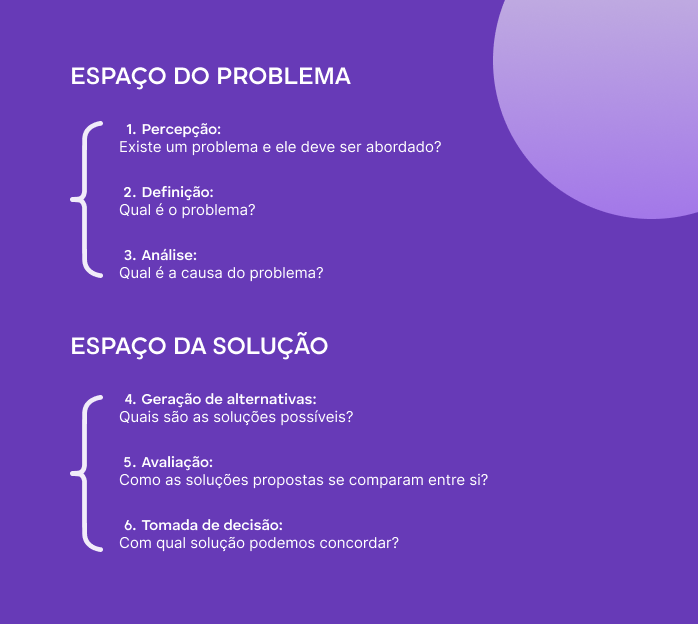
Mecanismos de substituição (fallback)
Nem sempre é possível chegar a um consenso.
Às vezes, pontos de vista alternativos são muito distantes para encontrar um meio termo. Em tais situações, insistir no consenso pode ser demorado e ineficaz.
As equipes colaborativas devem elaborar um mecanismo de fallback para tomada de decisão em situações em que o consenso é impossível. Esses mecanismos podem ser uma decisão hierárquica ou uma votação majoritária, um jogo de pedra-papel-tesoura ou qualquer outro modelo pré-acordado.
Ter um mecanismo de substituição (fallback) não apenas mantém o processo de tomada de decisão no seu curso, mas também pode motivar os participantes a trabalhar em direção ao consenso, pois o consenso sempre será percebido como preferível à alternativa.
É importante que a alternativa seja totalmente comunicada e que os participantes estejam cientes das consequências de não chegar a um consenso.
Princípio #3: Projete um mapa de processo
A colaboração não acontece espontaneamente. Ela precisa ser:
- Planejada
- Estruturado
- Facilitada
Antes mesmo que a colaboração possa começar, há uma infinidade de informações que já devem estar no lugar.
Para se comprometer totalmente, os participantes precisam ter um entendimento completo de como a colaboração será conduzida:
- Como o processo funcionará?
- Quem estará envolvido e em que capacidade?
- Quais são as responsabilidades específicas, cronogramas, recursos? etc.
Embora seja impossível prever completamente o curso e os resultados da colaboração, podemos definir a estrutura processual e planejar os processos para chegar a um consenso e implementar as soluções acordadas. Definimos o caminho para a ação sem saber qual será a ação.
Straus define essa estrutura processual como um "mapa de processo". É um conjunto de papéis e processos definidos e acordados coletivamente que prevê as etapas do processo colaborativo. Pense nisso como uma pauta de reunião bem estruturada, apenas em um nível mais alto.
O mapa de processo precisa ser suficientemente detalhado em termos dos mecanismos de colaboração, mas flexível o suficiente para facilitar a natureza imprevisível de tentativa e erro da resolução colaborativa de problemas.
Se tomarmos a pauta da reunião como um micro exemplo de um mapa de processo, ela não prevê o curso da discussão e quaisquer conclusões, mas pode definir:
- Pontos de discussão
- Funções específicas
- Cronogramas
- Outros detalhes que garantem que a reunião seja conduzida de forma eficiente.
Pode ser um documento altamente detalhado ou um diagrama, uma combinação de ambos, ou mesmo um acordo verbal não escrito entre todos os participantes. O importante é definir coletivamente e comunicar claramente os processos e os mecanismos de colaboração.
Além de ter um processo estruturado, ele também permite que os participantes se comprometam totalmente com o trabalho compartilhado, garantindo que ele será conduzido de forma organizada.
Princípio #4: Designe um facilitador do processo
Na maioria das colaborações, a resolução compartilhada de problemas e a tomada de decisões são feitas em reuniões. Assim, as reuniões são uma parte crítica do processo colaborativo e sua eficácia é essencial para o sucesso do esforço conjunto.
Conduzir uma reunião eficaz inclui múltiplas responsabilidades:
- Definir uma pauta de reunião
- Garantir que todos tenham a oportunidade de falar o que pensam
- Manter registros
- Tomar decisões
É pedir muito esperar que alguém assuma todas essas responsabilidades E participe ativamente da discussão.
Para aliviar um indivíduo de uma carga tão pesada de responsabilidades, Straus propõe a ideia de responsabilidade compartilhada pelo sucesso da reunião entre todos os participantes. Isso envolve diferenciar papéis e ter pessoas diferentes participando de diferentes aspectos da reunião.
Straus define 4 papéis distintos em uma reunião:
- Facilitador: um participante neutro e imparcial focado no processo
- Registrador: uma pessoa responsável por manter registros da reunião
- Líder: gerente sênior, responsável por garantir que a equipe permaneça focada na tarefa em questão e, mais comumente, tomar uma decisão se um consenso não puder ser alcançado
- Membro do grupo: participante ativo focado na resolução de problemas
Todos os participantes são responsáveis por garantir que os outros não saiam de suas funções. Ou seja, o facilitador impede que o líder domine a reunião, e o líder e os membros do grupo garantem que o facilitador e o registrador permaneçam neutros.
Embora prestemos mais atenção ao papel do registrador na seção seguinte deste artigo, agora nos concentraremos no facilitador.
Idealmente, um facilitador é alguém de fora do grupo colaborativo não imediatamente afetado pelos resultados da colaboração — por exemplo, um membro da equipe de RH. Isso é importante para garantir a neutralidade e seu foco no processo, e não no conteúdo da reunião.
Realize reuniões de equipe pelo Pumble
Funções do facilitador
O facilitador tem 4 funções principais:
- Guia de processo: responsável pelo processo de colaboração sem avaliar ou fornecer contribuição pessoal para a discussão, bem como desenvolver uma pauta de reunião e lidar com a logística da reunião.
- Doador de ferramentas: responsável por oferecer sugestões de processo (diferentes métodos de resolução de problemas e tomada de decisão) e certificar-se de que todos estejam claros sobre o método escolhido.
- Terceira parte neutra: responsável por remover quaisquer conflitos de interesse e exercício excessivo de influência, honrando o processo e garantindo que a contribuição de todos seja ouvida e compreendida.
- Educador de processo: responsável por educar os participantes sobre o processo enquanto eles facilitam – demonstrando técnicas (planejamento de processo, esclarecimento de funções, ferramentas básicas de resolução de problemas) que levam ao consenso e à colaboração produtiva.
Princípio #5: Aproveite o poder da memória de grupo
Os registros das reuniões desempenham um papel importante no processo colaborativo. Elas não servem apenas como um registro dos principais pontos de discussão para consideração posterior, mas também podem desempenhar um papel na moderação da reunião em tempo real.
Straus propõe um papel neutro de um registrador cuja única responsabilidade é capturar as principais ideias e conclusões apresentadas em uma reunião.
Além disso, todos os participantes são responsáveis pelo conteúdo do registro, pois o registrador captura os principais pontos de discussão de forma transparente e visível a todos (por exemplo, em um bloco de notas, um quadro branco ou um documento interativo).
O registrador não deve parafrasear o que foi dito, e os participantes devem corrigi-lo se discordarem dos registros. Straus chama essa abordagem colaborativa de manutenção de registros de "memória de grupo".
Manter registros de reuniões transparentes em tempo real ajuda a manter uma discussão eficiente e os objetivos da reunião no caminho certo, fornecendo clareza e evitando repetição, confusão e ambiguidade.
Em termos práticos, Straus propõe que os assentos da sala de reunião sejam dispostos em formato de U voltados para um bloco de notas, para que todos possam acompanhar a criação dos registros e fazer quaisquer correções.
É claro que as equipes colaborativas são livres para explorar e elaborar seus próprios métodos específicos de manter registros de reuniões, desde que garantam transparência e a contribuição de todos os envolvidos.
9 Dicas para criar uma equipe positiva e produtiva
Jon Gordon, autor de outro livro influente sobre trabalho em equipe The power of a positive team, enfatiza a importância da energia positiva em uma equipe, que ajuda os membros da equipe a se engajarem e causarem um impacto maior.
De acordo com sua crença, os membros de equipes positivas têm várias tendências cruciais em comum:
- Investem seu tempo e energia para criar um ambiente de trabalho positivo
- Trabalham juntos em direção a uma visão, que reflete um propósito maior
- Trabalham com otimismo
Então, vamos nos aprofundar em cada um desses comportamentos e analisar como eles causam um impacto positivo.
Dica #1: Invista seu tempo e energia para criar uma cultura de equipe positiva
A cultura da equipe define as suas crenças e expectativas, que influenciam os comportamentos dos membros e o futuro da equipe. Como Gordon diz, a cultura positiva da equipe é benéfica para seus membros de muitas maneiras:
- Melhora a conexão entre os membros da equipe
- Energiza e encoraja os membros da equipe
- Ajuda-os a aprender e crescer
Embora os líderes tenham um grande impacto na dinâmica da equipe, ela é criada por todas as partes envolvidas ― uma equipe é dinâmica, então cada membro tem um impacto com suas palavras, comportamentos e interações com os outros.
Gordon acredita que o erro mais comum que as equipes cometem é focar no resultado ou "fruto" em vez de "raiz" — o processo, os relacionamentos entre os membros da equipe e sua cultura.
Gordon acredita que o erro mais comum que as equipes cometem é focar no resultado ou "fruto" em vez de "raiz" — o processo, os relacionamentos entre os membros da equipe e sua cultura.
Dica #2: Trabalhe em direção a uma "visão compartilhada" com um propósito maior em mente
De acordo com Gordon, os principais fatores de toda colaboração produtiva de equipe são:
- Uma “visão compartilhada” que inspira os seus membros individual e coletivamente
- Um propósito maior do porquê eles estão comprometidos com essa visão
Ao contrário de metas numéricas, metas orientadas por propósitos capacitam os membros da equipe com maior comprometimento e energia. Portanto, sempre tente identificar o propósito do esforço da sua equipe, em vez de focar somente no número que você pretende atingir.
Mais importante, mantenha a visão e o propósito vivos. Gordon descobriu que a maioria das equipes deixa sua visão e propósito desaparecerem. Devido a esse problema, falar sobre esses conceitos regularmente é essencial.
”É poderoso fazer com que cada membro da equipe identifique e compartilhe o que a visão e a missão significam para eles e como podem contribuir para isso.”
Dica #3: Veja os desafios como novas oportunidades
Toda equipe tem altos e baixos ― falhas são inevitáveis e naturais. Mas, quando uma equipe encontra desafios, s precisam ver isso como uma oportunidade de aprendizado e crescimento.
Em vez de se sentirem frustrados com um obstáculo, as pessoas precisam tentar entender como superá-lo e o que devem aprender com ele para o futuro.
Dica #4: Implemente a regra de não reclamar
Embora seja da natureza humana reclamar, cair em um hábito mental tão negativo é prejudicial para manter relacionamentos interpessoais saudáveis, bem como para atingir objetivos pessoais.
As pessoas geralmente reclamam para comunicar suas insatisfações e se sentirem compreendidas.
No entanto, se a reclamação não for seguida de soluções, ela é inútil e tóxica. Ou seja pesquisas mostram que pensamentos negativos têm um impacto maior em nossos cérebros do que pensamentos positivos.
Portanto, equipes positivas implementam a "regra de não reclamar" ― não reclame a menos que tenha uma solução. Com essa regra, as equipes podem eliminar com sucesso a toxicidade e capacitar os membros da equipe a pensar e se comportar de forma construtiva, concentrando-se em soluções.
🎓 Dica profissional do Pumble
A maioria das pessoas já se deparou com uma situação em que foi solicitada a assumir responsabilidades extras. Em vez de reclamar, aprenda a definir limites profissionalmente. Confira nossa postagem no blog:
Comunique suas necessidades pelo Pumble
Dica #5: Discorde, mas de forma positiva
Embora algumas pessoas tendam a evitar desentendimentos para manter a harmonia e a positividade no local de trabalho, desentendimentos construtivos e respeitosos são uma parte saudável da colaboração em equipe.
Gordon enfatiza a necessidade de conflito em equipe. Se os conflitos nunca acontecem, significa que ninguém está fazendo perguntas difíceis ou discutindo questões importantes.
Mais importante, a ausência de conflito indica que ninguém desafia as opiniões dos outros membros da equipe e critica os outros para melhorar.
Portanto, desentendimentos podem contribuir para equipes saudáveis e produtivas, fornecendo melhores soluções e chances de crescimento.
Dica #6: Priorize a comunicação
Gordon diz: “A comunicação é frequentemente a última coisa que você quer fazer, mas é a coisa mais importante que você deve fazer.”
A comunicação da equipe é essencial para construir confiança e comprometimento. Para construir uma equipe forte, os membros precisam de uma comunicação forte, o que implica habilidades para:
- Falar efetivamente
- Ouvir com atenção
- Receber feedback
- Usar informações processadas para tomar decisões que sejam do melhor interesse da equipe
De acordo com o modelo 3C de equipes multifuncionais, o trabalho em equipe de alto desempenho consiste em três elementos que representam atividades relacionadas:
- Comunicação
- Colaboração
- Coordenação, o que implica visibilidade do progresso e das direções de cada equipe.
Portanto, esses elementos são atividades essenciais de toda equipe interfuncional, bem como de uma equipe funcional.
🎓 Dica profissional do Pumble
Falando em habilidades de comunicação em equipe, é muito importante ser um ouvinte ativo. Para aprimorar suas habilidades de escuta ativa, certifique-se de conferir nosso artigo:
Uma ótima maneira de fortalecer a conexão e a colaboração da equipe é ter conversas individuais.
Quando se trata de comunicação entre um líder e um membro da equipe, as reuniões individuais são uma maneira especialmente eficaz de manter todos engajados e motivados.
Dica #7: Reserve um tempo para comunicação individual
Mais importante, esta é uma maneira valiosa de superar desafios e encontrar obstáculos relacionados à colaboração em equipe.
Conversas individuais frequentes e curtas são um dos métodos de colaboração mais eficazes que ajudam os membros da equipe a permanecerem no caminho certo e encontrarem seu propósito maior.
Realize reuniões individuais pelo Pumble
Dica #8: Comunique-se de forma eficaz com um aplicativo de colaboração em equipe
Falando das práticas de comunicação mais eficazes, saber qual método de comunicação utilizar é tão importante quanto a forma como nos comunicamos com nossos colegas de trabalho.
Assim, escolher a ferramenta de comunicação certa que atenda às necessidades da equipe é uma prioridade e a única maneira de garantir uma comunicação eficaz.
Pumble é um software de colaboração de equipe que ajuda equipes remotas a confundir a linha entre comunicação real e virtual e colaborar de forma fácil e eficaz. Com o Pumble, você pode:
- Trabalhar juntos em canais e mensagens diretas
- Compartilhar arquivos
- Fazer chamadas de voz e vídeo e muito mais
Um dos melhores recursos do Pumble é um histórico de conversas gratuito, para que os usuários possam ter acesso ao histórico de mensagens de todas as conversas desde o início gratuitamente.
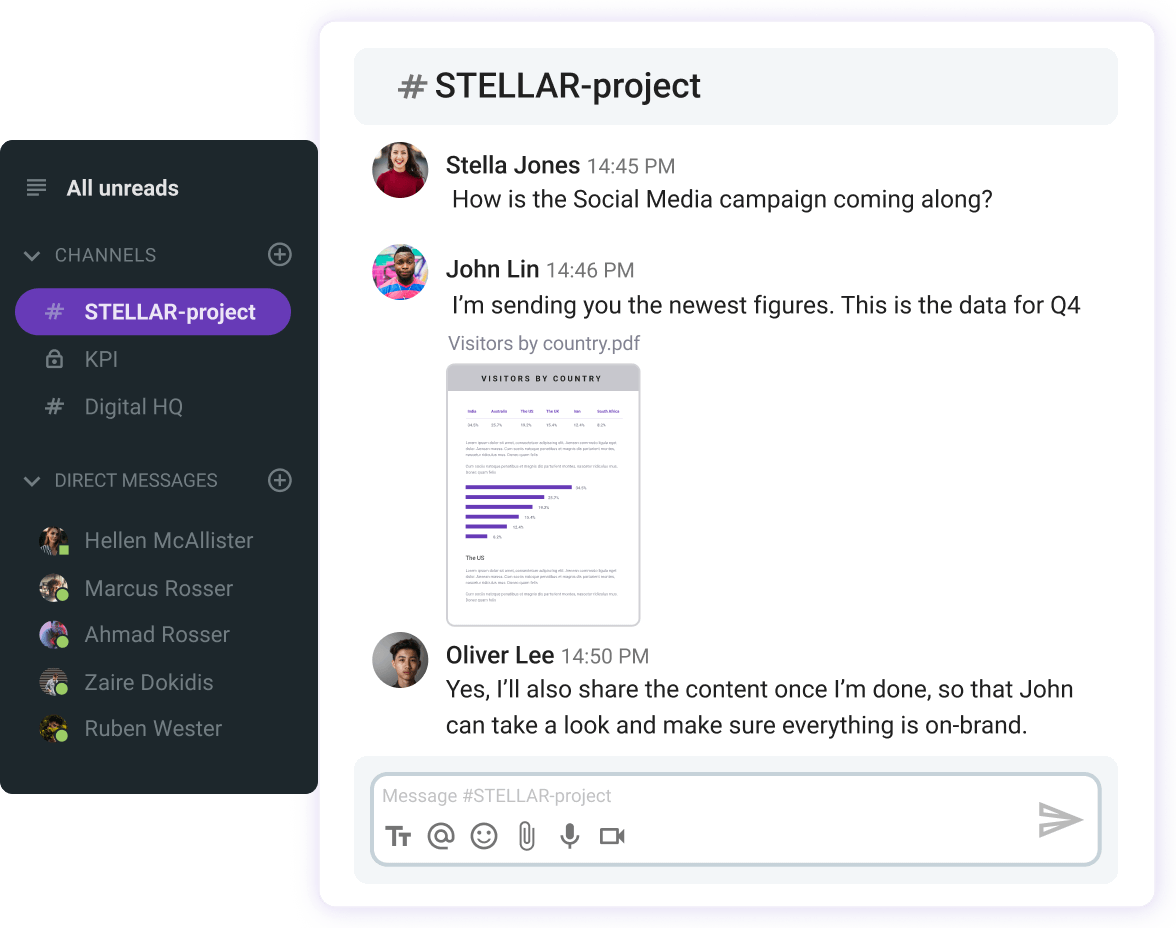
Dica #9: Não subestime o poder da formação de equipes
Embora algumas pessoas negligenciem o poder da formação de equipes, essas atividades são uma ferramenta essencial para melhorar a colaboração e a coesão do trabalho entre os membros da equipe.
De acordo com um artigo da Forbes, a formação eficaz de equipes é o investimento mais importante de toda organização bem-sucedida, porque leva a:
- Funcionários mais engajados
- Colaboração aprimorada
- Boas vibrações entre os funcionários
Quando se trata de exercícios de formação de equipe, Gordon enfatiza a importância de cumprir os seguintes critérios:
- Vulnerabilidade
- Transparência
- Autenticidade
Exercícios de formação de equipe que levam as pessoas a serem vulneráveis, transparentes e autênticas são maneiras eficazes de calar o ego e melhorar a conexão entre os membros da equipe. Como resultado, eles têm relacionamentos significativos e se comprometem mais com a equipe.
Componentes de atividades de formação de equipe, como narrativas vulneráveis, experiências compartilhadas e desafios comuns são maneiras poderosas de estabelecer um ambiente de trabalho positivo e melhorar a colaboração e o desempenho da equipe.
Como construir confiança na equipe?
“A confiança é a base de todas as equipes e, sem ela, elas não podem ter um bom desempenho.”
― Eric Coryell
Em seu livro sobre trabalho em equipe Revolutionize teamwork: How to Create and Lead Accountable Teams, Eric Coryell descreve princípios eficazes para um grupo produtivo, que incluem comportamentos de equipe que aumentam a confiança e levam a um melhor desempenho e colaboração.
Em vez de ignorar problemas ou falar mal dos colegas, Coryell está confiante sobre a importância de abordar os problemas reais juntos.
Trabalhar juntos para resolver os problemas é benéfico para a colaboração em equipe das seguintes maneiras:
- Traz diferentes perspectivas para a mesa e gera mais opções de soluções ― quando todos os membros da equipe compartilham seus pensamentos e diferentes perspectivas, o problema tem mais probabilidade de ser resolvido com sucesso e eficiência. Além disso, todos podem contribuir para a resolução de problemas, o que aumenta o senso de comprometimento.
- Aumenta a transparência na equipe e o suporte entre os membros ― comunicação transparente reduz as chances de falta de comunicação e de falar pelas costas de alguém.
- Contribui para definir expectativas e limites claros ― quando os membros da equipe abordam o problema e trabalham juntos, as normas e limites do grupo podem ser facilmente estabelecidos.
- Fortalece a equipe e aumenta a confiança ― os relacionamentos da equipe são enriquecidos com mais confiança e comprometimento.
Garanta uma comunicação transparente com o Pumble
Os erros mais comuns que quebram a confiança
Coryell enfatiza a importância da confiança no trabalho em equipe e descreve os erros mais comuns que prejudicam a confiança:
- Falar mal dos outros antes de abordar um problema real
- A tendência dos membros da equipe de não falarem em nome próprio
A maioria das pessoas tende a falar sobre o problema pelas costas para obter informações adicionais ou validar seu ponto de vista.
No entanto, essa prática é certamente uma maneira ineficaz de resolver problemas. Embora algumas pessoas se sintam melhor e sejam reveladas quando o fazem, esse comportamento leva a consequências negativas de longo prazo que podem prejudicar significativamente o trabalho em equipe e a confiança.
Além de falar pelas costas dos outros, evitar falar por si mesmo é a maneira mais prejudicial de resolver problemas reais.
As pessoas geralmente fazem isso usando pronomes de grupo, como nós ou eles. Em vez de dizer: ”"Notei que você tem se atrasado para as reuniões ultimamente", algumas pessoas dizem: "Percebemos que você tem se atrasado para as reuniões ultimamente".”
Os principais problemas com a frase da letra são os seguintes:
- O membro da equipe pode facilmente ficar confuso devido à ignorância do que você quer dizer com "nós"
- Eles podem concluir que você já estava falando com outra pessoa sobre eles sem o conhecimento deles, então aqui a confiança começa a se quebrar
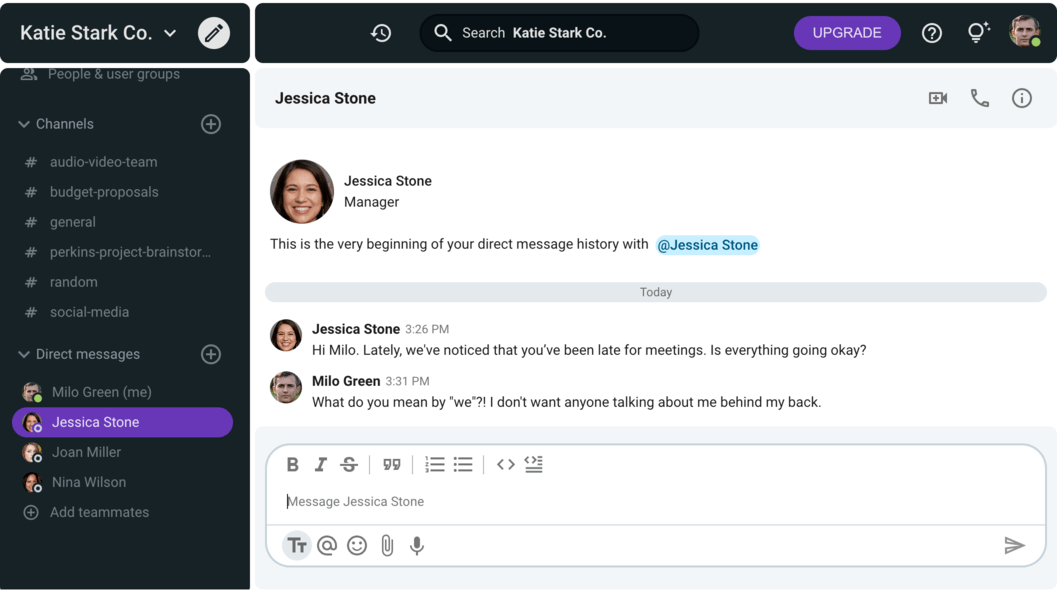
O segundo comportamento que demonstra evitar falar por si mesmo é fazer uma pergunta em vez de fazer uma declaração.
A maioria das pessoas costuma fazer perguntas sugestivas quando querem que outras pessoas concordem com elas, o que é, sem dúvida, uma prática de comunicação ineficaz.
Por exemplo, elas perguntam: "Você não acha que deveríamos mudar nossas prioridades de tarefas?" Em vez disso, uma maneira mais apropriada de se comunicar é dizer algo como isto: "Acho que seria uma boa ideia se priorizássemos nossas tarefas de forma um pouco diferente."
Dessa forma, você se comunica de forma assertiva e demonstra seu respeito, sem agressividade passiva.
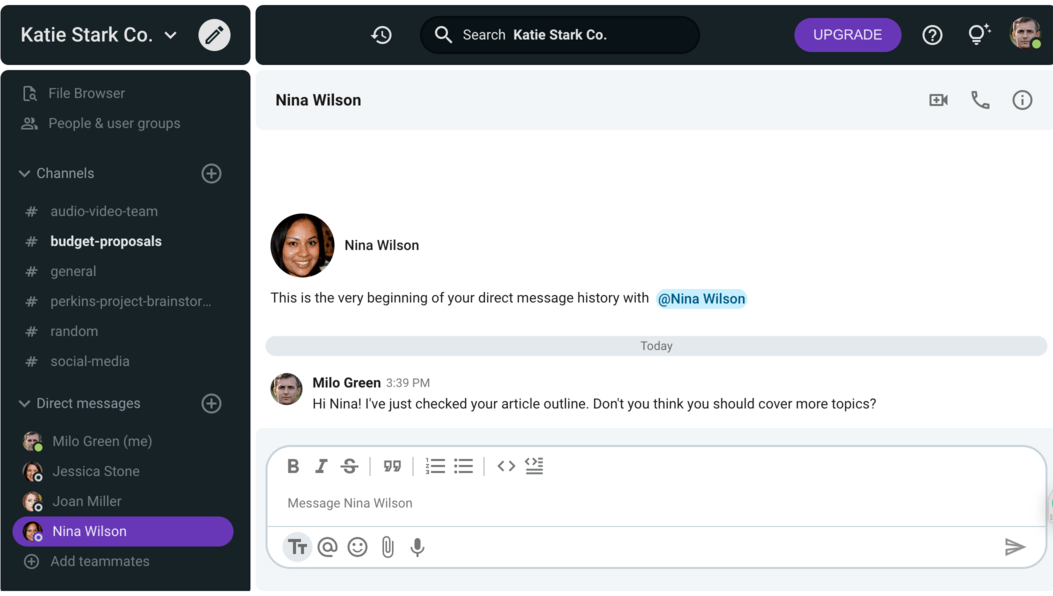
Promova uma comunicação assertiva no Pumble
🎓 Dica profissional do Pumble
Para saber mais sobre comportamentos que levam à má comunicação da equipe, confira o seguinte artigo:
Como criar responsabilidade e gerenciar a responsabilidade com sabedoria?
Um dos desafios mais comuns que as equipes encontram é uma abordagem inadequada para o gerenciamento de responsabilidade. Em outras palavras, pode acontecer que não esteja claro se o líder ou os membros da equipe devem cuidar de um determinado problema.
Devido a expectativas pouco claras, a equipe pode ficar presa em problemas não resolvidos, então é fundamental deixar claro quais decisões são do líder e quais são de responsabilidade dos membros da equipe.
Além dos seis estágios de construção de consenso de Straus que já discutimos, existem vários modelos de tomada de decisão, mas um dos mais comuns que equipes bem-sucedidas implementam é o modelo RACI.
Dica #1: Implemente o modelo RACI
O modelo RACI pode ser implementado em vários processos:
- Processos de tomada de decisão
- Processos de resolução de problemas
- Processos de gerenciamento de projetos
De acordo com o modelo RACI, independentemente do tipo de processo, as equipes precisam esclarecer quem é:
- Responsável ― Uma ou várias pessoas que são responsáveis por concluir a tarefa ― em outras palavras, quem “possui” a decisão ou problema. Essas pessoas geralmente ocupam cargos de desenvolvimento.
- Atribuído ― Os atribuídos geralmente são gerentes ou líderes, que orientam os responsáveis para garantir que compreendam as expectativas.
- Consultado ― Partes que são consultadas antes que uma decisão seja tomada, um problema seja resolvido ou a tarefa seja concluída ― fornecem opiniões e feedback.
- Informado ― Pessoas que devem ser informadas sobre a resolução do problema, decisão ou progresso do projeto. Geralmente ocupam cargos de chefia, diretoria ou liderança sênior.
Dica #2: Comunique expectativas claramente
Cada membro da equipe precisa saber o que é esperado deles individualmente e colaborativamente. Além disso, todos precisam receber feedback sobre seu desempenho de forma transparente e clara.
Ter conversas sobre desempenho com seus colegas de equipe ou líder de equipe oportuna e assertivamente contribui muito para a colaboração da equipe e para uma boa atmosfera na equipe.
Em vez de falar pelas costas das pessoas, uma das melhores práticas de trabalho em equipe é comunicar as expectativas, pois isso ajuda a:
- Criar confiança
- Melhorar o desempenho
- Aumentar o comprometimento
🎓 Dica profissional do Pumble
Se você não tem certeza de como e quando pedir feedback ao seu gerente, confira nossa postagem de blog sobre o tópico:
Dica #3: Lidere pelo exemplo
De acordo com Coryell, dois fatores principais que definem a liderança são:
- Comportamento do líder
- O que eles toleram
Então, como líder de equipe, você só pode mudar e melhorar sua equipe se modificar seu comportamento e parar de tolerar comportamentos de outros que prejudicam a confiança e a colaboração da equipe.
Por exemplo, se você não quer que seus colegas de equipe falem sobre um problema sem o conhecimento dos outros, certifique-se de nunca fazer isso.
Se você está ciente da importância de fazer declarações em vez de fazer perguntas passivo-agressivas, pare de tolerar esse comportamento em você e em outros colegas de equipe.
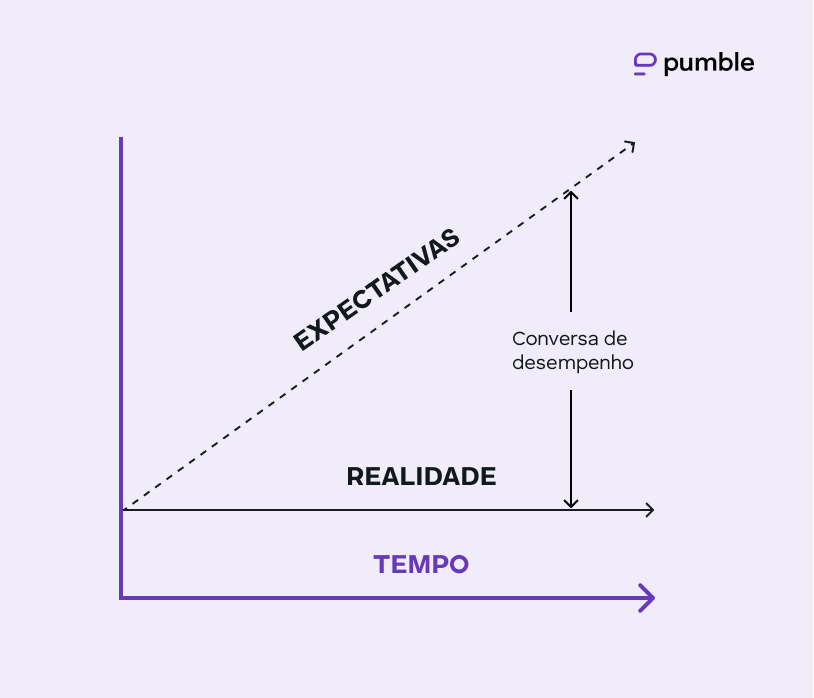
🎓 Dica profissional do Pumble
Se você quiser saber mais sobre comunicação de liderança eficaz, confira nossas postagens de blog:
Estratégias de RH que ensinam os funcionários a colaborar e promovem um senso de comunidade
De acordo com um artigo da Harvard Business Review’s article, estudos mostram que duas práticas de RH têm um grande impacto no desempenho e na colaboração da equipe:
- Treinar funcionários para garantir comportamento colaborativo
- Apoiar um senso de comunidade
A estratégia de RH acima pode fazer uma diferença importante na colaboração da equipe ao melhorar as habilidades dos funcionários em várias áreas, como resolução de conflitos.
Quando se trata de apoiar um senso de comunidade como uma estratégia de RH, ela inclui eventos e atividades que fazem os funcionários se sentirem parte da comunidade, o que promove um ambiente de trabalho positivo.
A comunidade no local de trabalho contribui para a conexão significativa entre os funcionários, o que leva a mais engajamento e melhor conexão com o trabalho.
Para garantir uma colaboração produtiva da equipe, os líderes de equipe precisam ser orientados para tarefas e relacionamentos ― portanto, implementar estratégias de RH adequadas é certamente uma grande ajuda para conseguir isso.
🎓 Dica profissional do Pumble
As citações de trabalho em equipe nos ajudam a entender a importância da colaboração e comunicação eficazes em equipe. Para encontrar citações inspiradoras para uma melhor colaboração, confira o seguinte artigo:
Use o Pumble para impulsionar a colaboração produtiva
A colaboração produtiva é um processo delicado que depende de uma variedade de fatores. Como mencionamos antes, a comunicação eficaz é uma das mais importantes que podem ser facilmente facilitadas usando as ferramentas certas.
O Pumble é o aplicativo de comunicação de equipe ideal para todas as equipes que buscam melhorar a produtividade e garantir o sucesso de toda a empresa. O Pumble pode acomodar diversas necessidades e preferências para criar um ambiente colaborativo perfeito. Com sua interface intuitiva e recursos abrangentes, o Pumble promove o diálogo aberto, a tomada de decisão rápida e o gerenciamento eficiente de tarefas e projetos.
Embora a colaboração produtiva exija atenção cuidadosa a vários elementos, a comunicação eficaz serve como sua pedra angular. Ao alavancar ferramentas como o Pumble e nutrir uma cultura de colaboração, as equipes podem superar desafios, capitalizar oportunidades e, finalmente, impulsionar o crescimento e o sucesso organizacional.
Permita que sua equipe alcance a grandeza além das capacidades individuais — crie uma conta gratuita no Pumble hoje mesmo.
Como avaliamos esta publicação: Nossos escritores e editores monitoram as postagens e as atualizam quando novas informações ficam disponíveis, para mantê-las atualizadas e relevantes.





